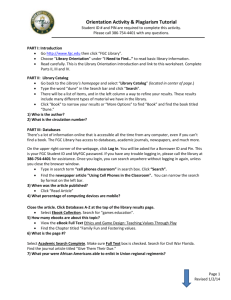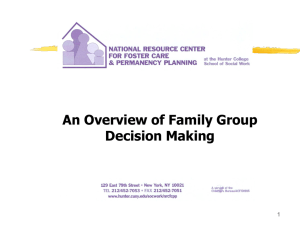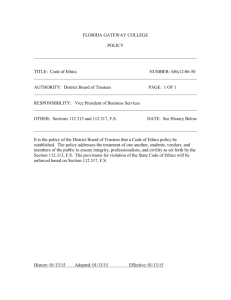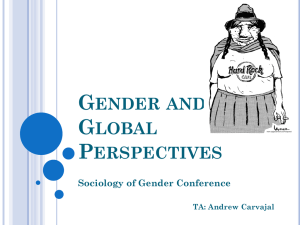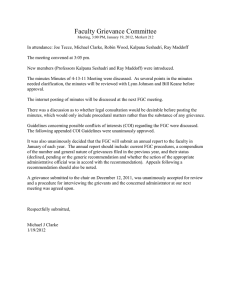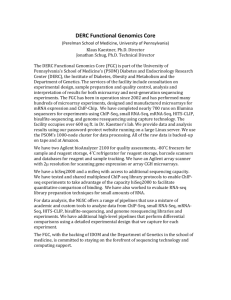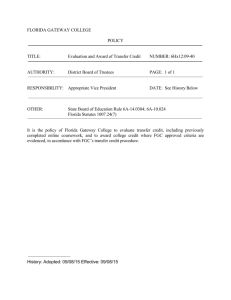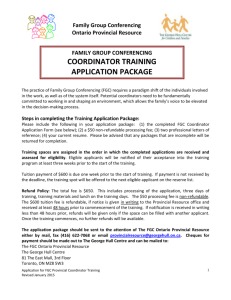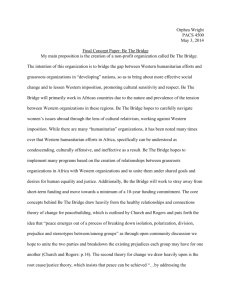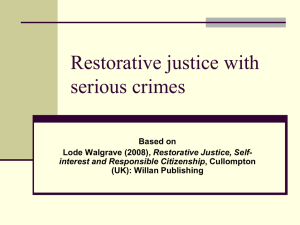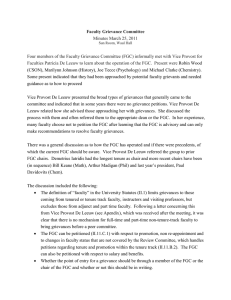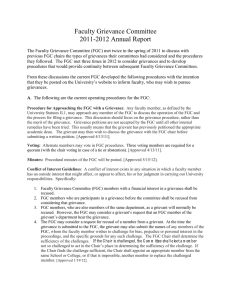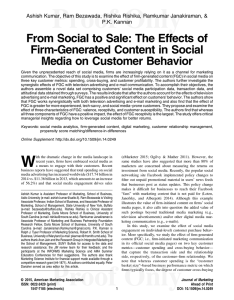the limits to our research seeking to understand
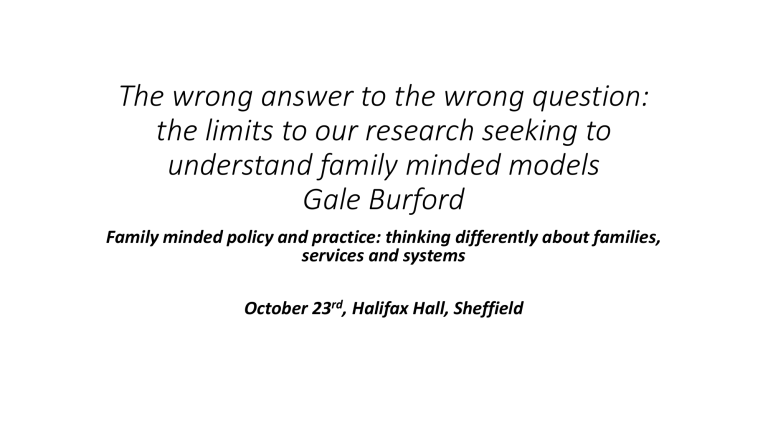
The wrong answer to the wrong question: the limits to our research seeking to understand family minded models
Gale Burford
Family minded policy and practice: thinking differently about families, services and systems
October 23 rd , Halifax Hall, Sheffield
The Need For Parallel Process
“The first responders to a violent situation are usually friends, family, community members, and clergy. … Why aren’t we doing more to equip them with the knowledge and the skills to be able to intervene effectively?” Mimi Kim: http://mediaforchange.org/reimagine
Challenges in evaluation
• Contextually adapted practice so builds in modifications
• Utilized at different stages of work so intended outcomes vary
• Integrated into wider reform efforts so difficult to isolate its contributions
• Little agreement about what constitutes the ‘traditional’ or ‘standard’ or business as usual - CPS model in comparison studies
• Work in child protection and youth justice is ‘high stakes’: under pressure to have indications that reassure continuation of efforts
• Research is not shedding light on the questions that need to be answered
• Started out with everyone being wholly preoccupied with ‘is it safe’ for the child to bring their extended family together?
• Turned then to therapeutic outcome measures: does family meeting have ‘therapeutic’ results? (therapy control)
• Does it have behavior control results (do people self regulate)
• Onus on families to ‘prove’ that their meeting does not have harmful results on the child (Florida study)
• Drivers/Sponsors of Evaluation & Research on FGC and Family
Engagement practices
• Choice of methodology
• Dissemination: Professional or Media
• Aggregating findings from programs of varying size, purpose, quality, etc. invariably results in luke warm or no findings
• Few studies with family or community level data
• Studies tend to be about individualized intervention but most families receive multiple interventions at same time or sequentially.
Remember the “Nothing Works” Debacle?
• Under the mantle of ‘science’ claims making is still claims making: two examples
No Treatment Effect
• “Using sibling data still finds no treatment effect of family group
conferencing on child welfare outcomes” (Duder, http://www.cecwcepb.ca/researchwatch/711)
Why keeping it in the family doesn’t work
(Michael Little)
Mike Little’s Web Page
• http://www.preventionaction.org/what-works/why-keeping-it-familydoesn-t-work/5502
• How is ‘family’ theorised in practice / by practitioners?
• How do families understand they are understood and what are the consequences?
• What can we learn from international developments in family minded research policy and practice?
• How do systems and service design help or hinder family minded practice?
• Are strength based models of family services possible in a risk saturated organisational cultures?
• What impact on system of services does the implementation of family engagement have? FGC is an intervention into a system seen to be dominating their lives.
• Impact of listening to families is that system begins to organize around the needs of family.
• What changes do workers make, do supervisors, do partnering agencies make in way(s) they work in as a result of including whole families as partners in their work: we continue to study the children, families and parents as objects of interventions by the state and professionals: “no treatment effect yet”.
• Do the families even know of the changes orgs are making and how do they experience these efforts: vt interviews with teens and parents
• Failure of system to communicate to parents that fgc sos were things they had on offer to help them get their kids back…. Asked parents who were fighting the system…. How was it presented to them, by whom? When at what stage of the process.
• The idea of involving extended family does not resonate well with some families if it is introduced too early or without clear understanding of the consequences to the child of their not involving other people in their child’s life
• Evidence? Of What? To Whom? For what purpose(s)?
• Dangers associated with selective application/generalization of studies without systematic review
• But systematic reviews have tended to count studies that use a particular methodology and ask particular questions
“Neglected” Neglect and
Sites Not Different
• According to researcher: Under pressure to “prove” private time
“works” – tried to make two studies out of one
• Neglect and abuse in the Swedish study “the impact of the FGC was scant, accounting for 0–7% of the statistical variance of outcome variables”
What the ‘science’ shows:
• Family is hard to measure – this type of research privileges “Individual” therapies, not family engagement
• What we can say from the accumulation of “scientific” studies so far is that they fail to disprove the hypothesis that engaging families is a good idea
• And we we have a lot of “proof” (evidence) of how ineffective it is to "leave the family out“, and to move children from place-to-place in the care system [think “child rescue”, residential schools, young people aging out, changes in schools, etc.]
• Dealing with systemic and organizational barriers to implementation
• Ongoing quality assurance of fidelity
• Building consensus about outcomes and developing measures
• Continually finding new ways to infuse the values in the work
PARENT
ONLY
FAMILY
Family Rights and
Family Engagement
• Does family engagement translate family rights into practice?
• And what happens when child welfare engages families?
21
Researcher Involvement
• Contested research/evaluation approaches – widely differing assumptions
• How researchers position FGC theory, practice and policy is important dimension of research
From the review of the reviewers
• The Cadillac
• FGDM is an “anything goes” model
• No treatment effect
• Totalizing ‘what works/nothing works’ – another history – or the “No better than professionals” assertion
The Cadillac
• FGDM is the ‘Cadillac’ model
• Concerns about preparation and private time
• Legislation in US to shorten times to adoption even further
• Now want something faster (and cheaper and better)
• What were the principles driving preparation and private time?
• Needs of children/youth waiting
FGDM is “anything goes”
• Crea (2010, p. 199,) "Other approaches, including family group conferencing (FGC), also place family members at the center of the decision-making process, but give family members decision-making control in determining the outcomes of the meeting (Pennell, 1999).
• Variation: “FGDM gives over important decisions about child safety to families” (only professionals can truly keep children safe).
• Example of how preposterous the claims have become is found in the
Florida study: something about the fact of the family having been in a secret meeting that would cause more abuse to happen months or years down the road (private time as an opportunity for family to scheme together to pull the wool over the professionals’ eyes or for a dominant abuser to take control of the family and leverage impunity for themselves and enlist the other family members in collusion to be silent about their abuse)
“The first responders to a violent situation are usually friends, family, community members, and clergy. … Why aren’t we doing more to equip them with the knowledge and the skills to be able to intervene effectively?” Mimi Kim: http://mediaforchange.org/reimagine
• Morality, virtue, science and propaganda
• Media, advertising, public relations and
• Shame without relationships and connection
• Public and private opinion, judgement in the era of social media
• The Biomedical Industrial Complex: Diagnosis, Addictions: Big
Pharma,
• Everyone Child abuse, good or bad parenting, a “good mother”,
• Problem creation and framing is a social, political, and economic issue with billions of dollars at stake, as shown by the promotional activities of the biomedical industrial complex. Gambril, 2015
• In particular with investigations, all discussions around identification, assessment, planning and evaluation center around the protection of the definitions and the framing of questions as determined by the authorities.
• Scientific methodology pits approaches against each other and cancel one another out unless one so clearly triumphs over all the others.
The ‘difference’ that is accepted in scientific studies to cancel one out is very small.
• Differential and mixed method approaches build on and work to match clients and approaches, answer questions about what is working?
Seamless RJ Systems
• Canadian woman’s diagram
• Vermont’s sequential intercept
Requirements of seamless RJ
• Who tells whom about availability of RJ options, when do they tell them, what is it they tell them:
• Independent person doing the telling;
• Configuration of affected persons [who is told first etc]
• What are options [public, private, local, elsewhere], how get information about those options and what is expected/involved with those options and what is the expected outcomes and what can go wrong
• What evidence is there about not taking an rj option, i.e., what are known consequences of opting for ‘formal’ interventions, or doing nothing, or not staying connected with family and community in cases of statutory interventions [placement of kids, incarceration, etc.]
Loneliness is lethal
• https://www.youtube.com/watch?v=_0hxl03JoA0&feature=share
Family dynamics: preparation = safety
She [the mother] is a criminal. She’s a drug addict. She is all the things you don’t want [a mother] to be. . . I don’t think she’s going to change.
It’s frustrating to know that there’s nothing I can do about that. . . Do I think she is a fit mother? Absolutely not. We just told DCF we’re just waiting for something to happen for them to actually do something.
Something’s going to happen to one of those children. I just feel it. . . I think it would be better to go to maybe meet with the social worker before the meeting and voice our concerns. To be able to feel more comfortable voicing our concerns without [mother] in the room. . .
We’re rushed through. . An hour is not long enough. . Social worker was supposed to call me every [week]. . And there would be weeks at a time when he wouldn’t.

